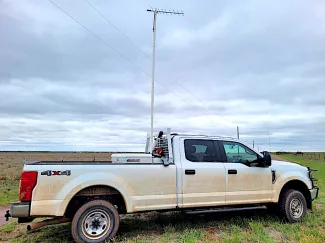
Researchers Log Wild Turkey Nest Depredations in April
WILD TURKEY POPULATION DYNAMICS AND BROOD SURVIVAL PROJECT REPORT FOR APRIL 2023
Provided by the Oklahoma Cooperative Fish and Wildlife Research Unit, Oklahoma State University
Wild turkey genetics, nesting success, and brood survival are among the focus areas in a planned 4.5-year study launched at the beginning of 2022 by the Oklahoma Department of Wildlife Conservation, the Oklahoma Cooperative Fish and Wildlife Research Unit, other state and federal entities, and private landowners working together to address wild turkey population dynamics. Following is a summary of recent study activities.
Southwestern Population Study Area: The research team continued monitoring radio-marked hens (see photo) and registered 13 nest initiations during April, one of those being a second attempt after a first attempt failed. By May, five nests were being incubated and eight nests had been lost to depredation. One of the hens died due to the nest depredation event, while the other seven survived. Two additional hens perished during April, for a total of three mortalities in the southwest. Two of those mortalities were attributed to depredation and one to an unknown cause. A hunter reported harvesting a tom banded earlier this spring. All perished hens’ transmitters were swabbed for environmental-DNA to determine the species of the predator.
Of the failed nests, the range of estimated incubation days was two to 10 days, with an average of 4.6 days. All depredated eggshells were swabbed for e-DNA to determine predator species. Researchers were tracking and monitoring 26 hens in the southwest. They also deployed game cameras for predator density estimates on a 3,296-acre area with known turkey nests. All 50 game cameras were expected to be operational by early May.
Southeastern Population Study Area: The research team deployed game cameras to monitor carnivores and hen nesting activity. Seven female mortalities, five of which occurred in February and March, were confirmed during April, for a total of eight mortalities since January. Both mortalities that occurred during April were attributed to depredation. In April, the team was tracking and monitoring 34 hens in the southeast. One of the four missing hens from last year’s captures was relocated during April.
At the end of April, eight nests had been identified, with six being incubated and two lost to depredation. At the first failed nest, researchers found evidence the hen was attacked or otherwise tried to defend the nest; it survived, but the nest containing at least five eggs was lost during or after the event. At the second failed nest, researchers found at least six eggs and signs of depredation. In April, a hunter harvested a tom that was banded in spring 2022. The harvest was in Arkansas, about 4 miles from the banding location.
Genetics Study: In April, about 400 tissue sampling kits were sent to ODWC, tribal nation collaborators, hunting guides, and individual hunters. Tissue samples were collected during youth and regular turkey hunting seasons from across the state. Samples from individual hunters were returned via mail to Caesar Kleberg Wildlife Research Institute. An Institute scientist was expected to visit Oklahoma after the hunting season to obtain the remainder of the harvested samples from our collaborators and OSU. Additionally, New Mexico Department of Game and Fish collected a few samples from pure Merriam’s turkeys as well as potential Merriam’s/Rio Grande hybrids for comparison to the samples, which provide insight on potential hybridization/introgression occurring between the two subspecies.
(Financial support for this publication was provided by the Oklahoma Department of Wildlife Conservation through the Wildlife Restoration Program, F21AF02702 [W-216-R-1] and Oklahoma State University.)